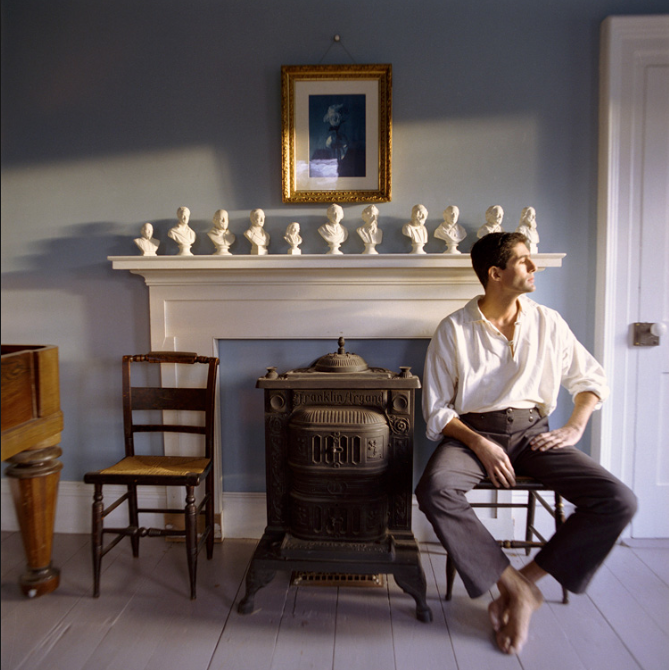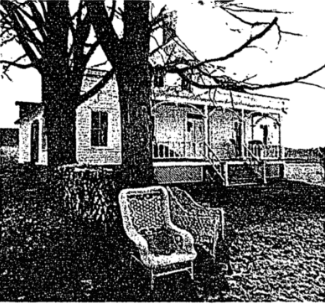John Dugdale: Fearless Vision Brings an Artist Home
By CHRISTOPHER MASON
John Dugdale at Lockwood Farm. Photo: Stefan Studer for NYT
WE grow accustomed to the Dark --/When Light is put away,''wrote Emily Dickinson, one of John Dugdale's favorite poets.
Mr. Dugdale sat, seemingly entranced by the glow from a fire lapping in the grate one afternoon last week. Auburn leaves were scampering past a window of the austerely beautiful blue parlor at Lockwood Farm, his 18th-century retreat in Ulster County, N.Y., but he could not see them.
Mr. Dugdale, 39, a fine-art photographer who lost almost all his sight following an AIDS-related stroke six years ago, has much to celebrate this Thanksgiving. Last Friday evening in Manhattan, he attended the packed opening of an exhibition of his recent still lifes, nudes and portraits. (Seventeen of the 65 pictures sold went to Elton John, a Dugdale collector.)
Photograhs by John Dugdale
And today, Mr. Dugdale will have the pleasure of welcoming his family, who have stood by him during his harrowing odyssey of suffering and recovery, to their first Thanksgiving at Lockwood Farm.
''The reason I love this house so much is that it has given me a purpose,'' he said.
Photograph by John Dugdale
''I'm planning to roast chestnuts in the fireplace, then paint my mother, sister and brother with cyanotype chemicals and watch them turn blue,'' he joked, alluding to the signature azure tint of his photographs, whose vintage allure derives from an obscure process invented by Sir John Herschel, the 19th-century British philosopher and astronomer.
A deep affinity for the spare rural aesthetic and customs of the mid-19th century informs the life and work of Mr. Dugdale, who recalled being aghast at the monstrous sea of shag carpeting, linoleum, Formica and Venetian blinds that greeted him when he first visited the house, in 1982.
Life's Evening Hour, Lacock Abbey, England, 1997. Photograph by John Dugdale.
''It was completely entombed in hideousness,'' Mr. Dugdale said. ''But the location, surrounded by cornfields, was wonderful. And I knew that if I stripped it to its bare bones, the house could be beautiful.'' Taking on a $110,000 mortgage with money scraped together working as a waiter, he purchased the ramshackle farmhouse and barn with 12 arable acres in 1983 and attacked the house ''with a crowbar and hammer and went berserk,'' he said. When the coal furnace gave up the ghost three days later, Mr. Dugdale installed a forced hot air system whose 20th-century hum so offended him that he ripped out the boiler: he traded it for a moth-eaten but splendid 19th-century wing chair. Relishing the spartan thrill of making do with two modest wood stoves to heat the 14-room house, he discovered that few friends were willing to join him for freezing winter weekends at Lockwood Farm during the eight years he lived there in its unfurnaced state. Even during the spring and summer, visitors were puzzled by Mr. Dugdale's decision to extract every electrical wire and light fitting from the house because he preferred the more authentic glow of kerosene lamps and candles.
"Smile For Your Lover Comes." Photograph by John Dugdale.
''I'm such a despot about what I like and what I surround myself with,'' he admitted. ''Even as a child, I felt I was born in the wrong century. Plastic gives me hives and modern design leaves me cold. But the simplicity of rural America between 1820 and 1840 slays me.''
Muybridge's Horse. Photograph by John Dugdale.
Offended by the presence of the 1950's windows, he replaced them with 19th-century frames he painstakingly reglazed with pieces of antique glass found in local junkyards. ''I'm a maniac for wavy glass,'' he said of the windowpanes in the cozy basement kitchen, which appear to sag with age.
When a relative of a previous owner offered him photographs of Lockwood Farm from 1880, showing a porch that had long since vanished, Mr. Dugdale faithfully recreated it, along with its traditional carved acorns, symbols of thrift. Slowly, he began adorning the house with treasures, including a rectangular 1856 Chickering piano for the blue parlor (a gift from a neighbor) and the results of many happy hours of scavenging -- a beautiful old sink discovered amid straw in a friend's barn, an ever-expanding collection of pink lusterware and blue Davenport china, housed in a rustic peeled-paint cupboard in the basement dining room.
Photograph by John Dugdale.
Working for several years as a successful commercial photographer (the only plastic object to be found at Lockwood Farm is the salad spinner he shot for his first assignment, in 1983), Mr. Dugdale and his dog, Juno, happily divided their time between an apartment in Manhattan and Ulster County. ''I named him after a Currier & Ives print I have called 'Juno: A Celebrated Pointer,' '' Mr. Dugdale said. ''He's actually a springer, but never mind.''
THIS rural idyll was interrupted in 1993 when he developed AIDS, along with a grim assortment of opportunistic illnesses, including cancer, viral meningitis, several bouts of viral pneumonia and a stroke that left him deaf in one ear and coincided with cytomegalovirus retinitis, which deprived him of all of his vision in one eye and 80 percent in the other (the result, he says is like looking through six Baggies). All this took place within two years.
''When I was in the hospital, what kept me going was thinking what I'd do to the house,'' Mr. Dugdale recalled. ''I paced the property daily in my mind, determined to finish what I'd started, convincing myself that I was the only one who knew what had to be done.''
After a wrenching year away that included a seven-month stint in St. Vincent's hospital in Manhattan, Mr. Dugdale returned for an emotional visit.
''Everything was just as I left it,'' he said. ''My teacup on the desk, the newspaper on the kitchen table, my pajamas on the bed.'' The house was unaltered, but he was profoundly changed. ''I came back almost blind, walking with a cane,'' he recalled. ''My sister, Kathleen, who's my best friend, was so patient. I said: 'I have to leave. It's too sad.' But she kept bringing me back here, and slowly I began to adjust.''
Upon regaining his strength, he dug a deep grave for the cast-iron bed in which he had endured five terrifying bouts of viral pneumonia that brought him close to death. ''I buried that bed in the yard so no one would ever have to sleep in it again,'' he said.
Reacquainting himself with the house while continuing to live there alone, Mr. Dugdale hired Lynn Snow, a local craftswoman, to paint every second step in the narrow stairway leading from the basement to the front hall a dark shade of gray in order to help him distinguish it from the existing white steps. And heeding the danger of knocking over those kerosene lamps, because of his impaired sight, Mr. Dugdale broke down and had the place rewired, installing 1890's Thomas Edison carbon filament light bulbs he found in a theatrical prop house. ''With my sight, they look like blurry fireflies,'' he said, admiring a bulb dangling from the ceiling in the front hall that casts an antique glow over a valuable 14-foot-long ochre-colored parson's bench he purchased in pieces from a homeless vendor on Houston Street for $200. ''These lamps are ideal for me because they don't create a glare,'' he explained, noting that the bulbs also last for 35 years.
And finally succumbing to his mother's pleas that he install a heating system, Mr. Dugdale bought a quiet furnace that now warms a collection of vintage cast-iron radiators he had accumulated from junkyards all over Ulster County. (In deference to her, he also installed a telephone, concealing the irritating apparatus in an antique closet in the kitchen.)
In Manhattan, Mr. Dugdale was obliged to make similar 20th-century adjustments. His apartment, which doubles as his photographic studio, is the top floor of an 1828 town house on a picturesque tree-lined street in Greenwich Village. To the consternation of his landlord, Mr. Dugdale had ripped out old electrical wiring and relied on candlelight, adding his favorite 1890's light bulbs and new wiring when it became necessary.
His passion for historical authenticity occasionally exasperates even his most ardent supporters. ''When John disappeared off to some obscure school in Massachusetts to learn how to construct a 19th-century fireplace for his studio I really thought he'd lost it,'' said John Wessel, who, with his partner, Billy O'Connor, gave Mr. Dugdale an exhibition at their Chelsea gallery, Wessel & O'Connor, after his stroke in 1993.
''One day, John came into the gallery, peering at photographs with a magnifying glass,'' Mr. O'Connor recalled. ''He explained to us what he had been through and asked if we would give him a show.'' They agreed to take a risk. ''A torrent of ideas came pouring out,'' Mr. O'Connor recalled. ''For John, this was clearly another chance at life.'' The work was full of lyrical images inspired by his intense experiences in the hospital.
Since then, Mr. Dugdale has had 38 exhibitions on four continents, with framed prints selling for between $800 and $2,500. ''I've been so blessed since this dismal thing that happened with my sight,'' he said. ''It means I'm able to complete projects on my house, which makes me very happy.''
USING a sense of composition honed during his years as a commercial photographer, he conceives of a picture first of all in his mind's eye. Fortuitously, the obscure cyanotype process Mr. Dugdale had been experimenting with before his illness turned out to be the safest method for an artist who could no longer tolerate toxic modern photographic chemicals. The results have the mysterious hue of architectural blueprints.
To capture his images, Mr. Dugdale usually uses a large, unwieldy wooden-framed 19th-century camera that dominates a corner of his high-ceilinged studio. To gather inspiration, he listens to books on tape from Recording for the Blind: he is a passionate devourer of the writings of Whitman, Thoreau and Emily Dickinson.
''Either the Darkness alters --/Or something in the sight/Adjusts itself to Midnight --/And Life steps almost straight,'' she wrote in a poem that accompanies the current exhibition.
Mr. Dugdale is happy to say his health has been excellent for the last four years, thanks in part to the 40 pills, including protease inhibitors, he takes daily.
He showed off a prized possession, an upright piano given to him by the performance artist John Kelly, an old friend, who informed him that it had previously belonged to Lypsinka, the legendary drag performer, and Robert LaFosse, the New York City Ballet dancer. ''How's that for a provenance?'' Mr. Dugdale said, laughing, before launching into a Bach toccata.
Remarkably, the determined Mr. Dugdale has only learned to play the piano since losing his vision. ''I'm not able to read sheet music, but I can play eight minuets, one prelude and one toccata by Bach,'' he said. He learns by listening intently as his piano teacher, Fernando Torm-Toha, plays for him, then he retraces the notes with his own hands.
At a dinner in his honor at a friend's SoHo loft following the opening of his exhibition, Mr. Dugdale was coaxed into an impromptu concert. It was the first time he had performed before an audience. After a tentative solo, Mr. Dugdale began accompanying Mr. Kelly, who sang ''Ave Maria.'' More than a few piano notes were mangled, but tears began to stream down the face of Mr. Dugdale's mother, Rose.
''You know what's wonderful?'' Mrs. Dugdale said afterward. ''My son never gave up hope.''
Published in the New York Times, November 25, 1999
Click here to visit JohnDugdaleStudio.com
Click here for the website of Stefan Studer (portrait of John Dugdale at Lockwood Farm, above)












